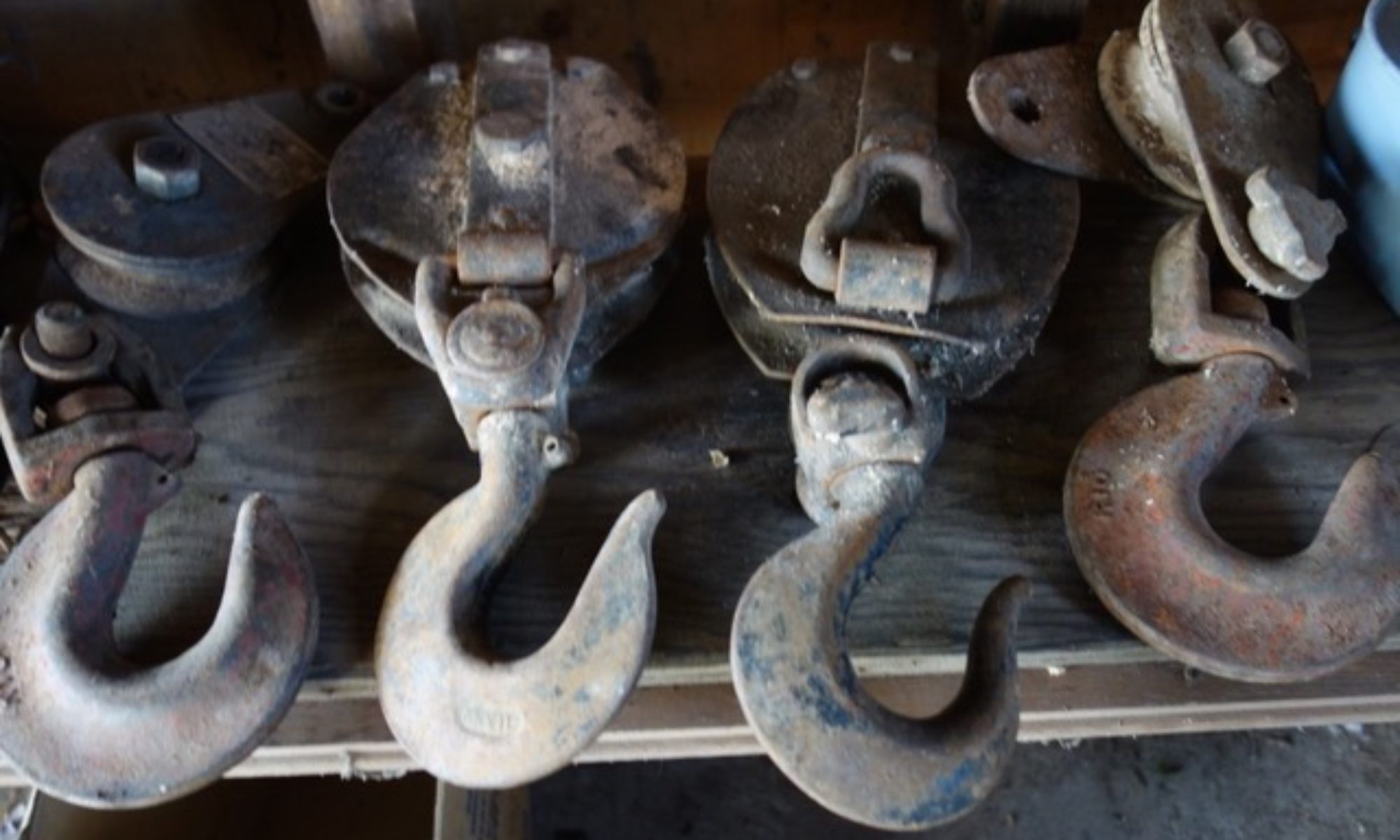MR SKEOCH WHAT IS A FUCKING IMMIGRANT?”

ALAN SKEOCH
feb. 2018
Telling the story as it unfolded
“Mr. Skeoch, what is a ‘fucking immigrant?’
“ Who said that to you?”
“ School”
And Pason Banjongpanith pointed to Queen Elizabeth Public School in Mississauga.
“Over there.”
“Well, Pason, I think you have a fight on your hands. Calling you a ‘fucking immigrant’ may lead to that.”
“No!”
“Afraid? I understand that.”
“No!”
“What if he hits you?”, I assumed that it must be a male, girls do not use that language. Wait a minute, society has changed, could be a girl.
“No fight.”
“Why not?”
Then Pason held one hand out flat about hip hight. Expression deadpan but hint of amusement. His enemy was some Grade Two kid.. A little person.
I shuddered to think what my fighting advice could have done. Pason had good sense and perhaps, I began to think, also a good sense of humour.
It was 1979. The Viet Nam war had ended badly and millions of Sour East Asians were fleeing many of them dying in efforts to escape because they had sympathized with US led forces in that ghastly war. The boat people captured global imagination. Thousands jammed on floating coffins fleeing.
“We must do something,…sponsor a family or send money?”, we debated in a congregational meeting at First United Church, Port Credit.
“Money gets there fastest,”
“But people need a place to go?
“We could do both.”
So one late winter day in 1979 we got word suddenly that our refugee family had arrived. Four teenagers. No parents. And they were Laotian, not Vietnamese. We were stunned but ready.
Divided up the labour…housing, food, clothing, employment, education.
“Alan, you and Marjorie are responsible for the schooling of Pason, the youngest. of the Banjongpaniths.”
And so for a few brief years we had a second son…unforgettable years. Humorous years. Pason latched on to Kevin and Andrew as puppies in a litter.
Our youngest Andrew was in Grade Five, Pason was placed in Grade Six…Kevin in Grade Seven. I was the father of three boys suddenly…or so it seemed. Not exactly a good father figure some thought. Need proof?
“Pason,” I said one day when his English was better, “do you know why I brought you to Canada?”
“No” he replied looking at me from the passenger seat of our truck as we headed to a farm auction sale,
“You are here for one purpose.”
“One purpose? What purpose?”
“If you fail at this purpose, I will send you back to Laos?”
“Purpose? What purpose?
“Wipe that grin off your face Pason.” , The nerve of him…colossal nerve…total disrespect. I thought Laotians were taught to respect their elders like the Chinese do. That was what Confucius taught. Damn, Pason has a wider grin now.”
“Why am I here, Mr. Skeoch/“
“First, help me attach this iron stone boat to the back of the truck. We can haul it to the farm. Maybe you would like to sit on it. Bumpy ride on ice and gravel.” We were attending a winter farm auction sale…rural Ontario.
Largely white men, older…mostly farmers and antique hunters. Lots of sidelong glances at Pason.
“Why am I here, Mr. Skeoch?”
“Simple. You are a bodyguard.”
“Bodyguard?”
“Yes!”
“Who am I supposed to protect?”
“Our other sons…principally Andrew as Kevin is older.”
“Did you say ‘other’ sons?
“Slip of the tongue Pason…slip of the tongue.”
“You did say ‘other’ sons. Does that mean you are treating me as a son like Andrew and Kevin?”
“OK, I said it.”
“No worries, Mr. Skeoch, I am a good wrestler, Andrew will be protected.
Yes, Having Pason around was like having a third son for those 2 or 3 short years while he was in school. He was good company…really interested in sharing his life with mine. He set up amusing questions. Take
this for example. We were driving down to Port Credit. School was out.
“Mr. Skeoch, did you ever smoke cigarettes?”
“Weird question Pason.”
“Did you?”
“Yes, when I was in Grade Ten I managed grab three Craven A cigarettes from a relatives pack. “smoked one of them before school with Bob Taylor and Bill Rankin who were real smokers.”
“Did you Like smoking?”
‘No. Asked myself ‘What the hell am I doing this for?’, then gave the other two cigarettes to Bob and Bill.”
“Why are you asking?”
No comment from Pason
“Have you, Pason, started smoking cigarettes?”
Pason looked over at me and said. “I am in Grade Ten.”
Pason had a great sense of humour. To this day I am not sure if he was setting me up or whether he had started smoking and wanted my advice. His comment, “I am in Grade Ten” made me laugh.
That was a long time ago. Passong is now an adult with a thriving optometry business in Brampton. Married with grown up kids of their own now …kids nearly adults. He dropped by at the farm a few months ago. Drove a big Mercedes… fit for the Prme Minister of Canada. He still has that lopsided grin. Never lost it.

Pason and his wife and his business in 2018
Now, so many years later, I have time to dig deeper into Pason’s life. How did the Banjongpanith escape from Laos. Why risk death? Back n the 1970’s there was not time for that. Our church Clerk of Session got a sudden phone call one evening.
“Your refugees are now in Canada. They will arrive at the church tonight.”
“How many?”
“Four.”
“Parents and two children?”
“No, four teenagers, all related.”
“What?”
“We expected a family, what are we going to do with four teenagers?”
“Your problem now, come and get them.”
Got them. No English. Plopped the four of them in a cheap motel outside Port Credit and proceeded to get them an apartment and all things needed to furnish it…tables, beds, chairs, pots, pans, dishes, clothes, bedding…piles of stuff. The four kids could not say much…a lot of hand gestures. Pason’s two older sisters assumed command of the group. Son Pet and Son Pong. Pason was the youngest. Pasa was the most enigmatic. Without speaking he communicated the fact he had managed on his own…that he knew the world around him was not always good. I never got to know Pasa very well. He could look after himself. We got him enrolled at Port Credit Secondary School and he looked after himself after that.
Now Pasa was younger…in between our kids. Or perhaps older than he admitted. Pasa knew how to fit in. He wanted to fit in…wanted to become Canadian even if it meant smoking a few cigarettes and learning how to use the ‘f’ word. Nah! I should not have said that. I never heard him use the ‘f’ except with that first question, “What is a fucking immigrant?”
All four of the Banjongpaniths were intelligent…as opposed to smarmy kind of smart. They had manners. Soon said please and thank you. They were Buddhists and knew all about walking the Middle Way…avoiding extremes. Fitting in. Big smiles. Gave of themselves rather than taking what they could. Our church was enriched immensely by their presence. We were appreciated without fawning , cloying, going overboard with bowing and scraping. All four enriched the lives of our whole congregation.
DELVING INTO LAOS…WHO WERE THESE PEOPLE…WHAT IS LAOS? WHERE IS LAOS? WHY FLEE LAOS?
Pasa, as I mentioned, was somewhat of an enigma. He seemed more battle scarred and cautious than his younger brother Pason. I never really got to know him well. Wished that were not so.
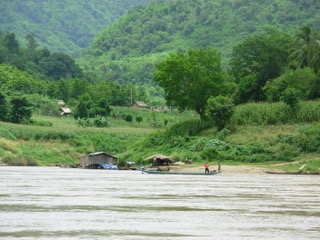
Mekong River, twelfth river in the world…brown
with mud and topsoil from Tibet, even Mouont Everest.
Passa swam the Mekong River…alone. With communist Pathet Lao solders taking potshots at him I was led to believe. Dead bodies in the Mekong were a fact of life in those days. Thousands of other Laotians wanted to escape the victorious communists. A lot of people died. Thousands. Tens of thousands. But Pasa lived. He made the decision to swim the Mekong on his own. Never told his mom or dad. just left one dark night with a small pack. Parents were irate. Pasa knew that it was very important that one of the family reach the other side of the Mekong, the Thailand side, before the rest fled. Why? Because no one trusted the semi-criminals who promised safe escort to Thailand. Escaping Laotians could not take much with them. so they carried
valuable portable wealth. Gold, cash, precious stones…money or things that could be converted into money. Some Ferry owners were just as likely to kill a family halfwy across and dump the bodies. Who would know? Who would care? If, on the other hand, there was a contact on the opposite bank of the Mekong with supporters trouble was less likely. Pasa knew this and just up and disappeared one night much to the chagrin of his father who wanted to engineer the escape of the whole family. Pasa was a very tough risk taker. Hardened.
Today we would call the Banjongpaniths economic migrants. They were not forced to make a run for the West. At least not yet. That may have happened
down the road for this was a middle class family. Yes, probably fairly affluent for they lived in a large new house in the city ofSavannaket and Mr Banjongpanith was a member of the professional business class… In the optometry business I think but am not sure. Within the crucible of Laotian politics the family would be considered capitalists and pro-American. That does not mean they knew any Americans. Suffice it to say they had a pro-Western bias. And having such views was dangerous once the Viet Nam war ended and everything fell to the victorious communist forces. Their educated children would be regarded with suspicion. In other, more acidic words,
their future was behind them.
Better to get out…to leave everything behind. To hope for a better life for the children. So much for the Banjongpaniths. What do we know about Laos in 1979?
LAOS
IF someone asked me where Laos was back in 1979 , I would have to shrug my shoulders. I did not know. I guess no one else did either for the question was never raised. We were too busy making a new home for these kids. At the time I wondered why we got a family from Laos and not from Viet Nam. No connection in m mind. But I said nothing and just did my job of helping the new kids fit into our society.
Pasit graduated from Port Credit high school in 1988 and then Ryerson in 1994 in Architectural Design.
LAOS? NEVER HEARD OF THE PLACE
Let me use an imaginary dialogue:
“Where did these kids come from? “
“Laos?”
“Laos, never heard of the place. Is that a city or a country?”
“Land locked nation in South East Asia.”
“Yes, bunch of countries there…Viet Nam, Thailand, Cambodian, Myanmar, Laos, etc.”
“So these kids are Laotians, I thought we were getting refugees from Viet Nam, maybe a family of boat people.
Instead we got these four kids from a country I’ve never heard about before. Where is Laos?”
“Has Laos any connection to the Viet Nam War?”
“have you ever heard of the Ho Chi Minh Trail?

HO CHI MINH TRAIL
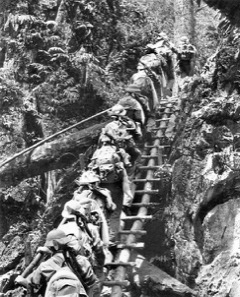


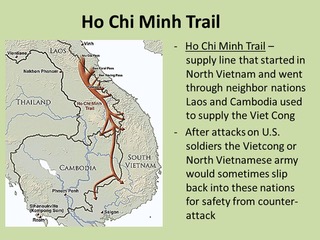
The Ho Chi Minh trail through jungle much of the time was used to ferry troops, and supplies for Viet Cong communist forces. In some place elephants were used in others, the trail was wide enough for convoys of trucks.
“Ho Chi Minh Trail…yes…heard Whispers…same jungle track used by Viet Cong..”
“Right, the jungle route for Viet Cong soldiers to infiltrate South Viet Nam”
“Through Laos?”
“Right. The US airforce between 1964 and 1973 dropped over 2,000,000 tons of bombs along the eastern Laotian border. They logged 580,000 USAF missions which made Laos the most heavily bombed country per capita in the history of the world…” equal to a planeload of bombs every 8 minutes, 24 hours a day, for 9 years.”
Even today in 2018 that part of Laos is dangerous killing or wounding 100 people per year from unexploded bombs.
Thousands of gallons of Agent Orange dropped to defoliate the jungle.”

This is one bomb crater on the Ho Chi Minh Trail. Those tiny dots in the muddy water are people. A huge crater…one of thousands.
“Was Laos an ally of the North Vietnamese?”
“Not completely. A Civil War was being fought in Laos dating back to the 1950’s when France tried to rebuild its colonial empire after the Japanese takeover in World War II. France failed in the end. But the Royal Laotian Army got into a bitter ‘take no prisoners’ decade long war with the Pathet Lao communist inusrgents.”
“Why have I never heard about this?”
“Because bigger wars were going on elsewhere. Have you ever heard of the Cold War?”
“Do you mean the big bloodless thermonuclear standoff between the Soviet Union and the West? “
“Yes, so much bigger than Laos. A bluffing game where huge squadrons of
nuclear armed American B 52 bombers countered similar Soviet Union bombers… ready for an Armageddon like no other. “
“Like that movie Dr. Strangelove with Peter Sellars?”
“Yes.”
“The Secret War in Laos was small change in the Cold War. Forgotten. Unknown to most of us in he West. But a secret war was being fought in Laos.”
“A secret war?”
“Laos was not a homogenous state. There were…and are…large numbers of different peoples living there. the Lowland Laotians in the south had good land and and large cities. Most were well educated. Many looked upon those of us in the West favourably. The Banjongpaniths came from the Laotian city of Savannaket whose colonial heritage to France can still be seen in many of the grand homes.”
“You said ‘secret war’ ?.”
“Complicated. Simply put there was a nasty civil war between the Lowland Laotians and the Highland Laotians living in the mountainous regions of Northern also. Even that is too simple. Northern Laos was home to a different people, the Hmong people, who were separate…not part of the communist guerrilla forces.
“Hmong? Getting me confused already! Who are the Hmong?”
“A large Laotian sub group whose roots are Chinese. Some 400,000 Hmong lived in Northern Laos. Indigenous people with a long history. They resented
the North Vietnamese and Pathet Lao forces invading their part of Laos. An oversimplification, sorry about that. But the Hmong are the key to understanding the Secret War in Laos.”
“How?”
“Hmong resentment of the North Vietnamese was the crack in the door for the American CIA…Central Intelligence Agency…that began arming, training
and support the Hmong.
“How many?”
“60% of the Hmong population were staunchly pro-American.”
“Hmong pilots for instance were often the men who rescued american pilots shot down over the Ho Chi Minh Trail. That is largely unknown to Americans and I hazard to say absolutely unknown to Canadians. During the Viet Nam War there was a Secret Army of Hmong fighting alongside American
soldiers. Many of these escaped Laos in 1975 fleeing across the Mekong River to Thailand.”
“How many?”
“The Hmong population in the United States today in 2018 is 260,073. Huge, with roots to this Secret Army.
“What happened to the Secret Army?”
“Fragmented into pieces. Something like 20,000 are now Canadians. They can be found in all western democracies in significant numbers. 60,000 Hmong were forcibly sent back to Laos where they faced so much persecution the they hid out in the jungles of Laos in small family groups where they are still to this day being “Hunted Like Animals” as documented in a film by Rebecca Sommer. Some Hmong are still fighting the communist government of Laos.
“Messy…hard to follow.”
“And still happening as one report started that ‘Significant number of…Hmong Animists and Christians, including Protestant and Catholic believers, have been subjected in the 21st century to military attacks, police arrest, imprisonment, extrajudicial killings, and torture for seeking to worship independently form the Marxist government of the Lao People’s Democratic Republic.”
“What has this got to do with Pason Banjongpanith?”
“Not much, I guess, Pasa and his family are not Hmong…they’re Laotians…different.”
“How do you know?”
‘An incident…”
“Incident?”
“Well, another nearby church had sponsored a Hmong family, probably connected to the Secret Army but we did not know that, and we decided to bring the two families together, after all, they were both Laotian. All Laotian immigrants. Should welcome each other…a chance to talk together. Not so. The meeting was an absolute failure..”
“Why?”
“I don’t really know.”
“What happened?”
“They were like strangers to each other. More than that. There was a tension in the meeting. No talk. No smiles. No discussions of life
in the refugee camp. Just an anxiety for the meeting to end which it did…fast.”
“Have you ever figured out why>”
“No but I have an idea.”
“Like?”
“Like, I think the Banjongpaniths were more economic refugees while the Hmong were political refuges. Two very different kinds of refugees.”
“The Banjongpaniths kids. were highly educated members of the Laotian middle class. Their parents were skilled optometrists with a thriving business and a grand house. All this was doomed with the communist takeover of Laos in 1975. The entrepreneurial class were suspect.
“Suspect? Capitalists. Enemy of Marian Socialism.
Western.”
“Why did they decide to flee…to leave everything.”
“Probably saw the writing on the wall. What they had would be confiscated by the state. Orthodox communism says that the rich will never voluntarily surrender their wealth. Never allow their wealth to be redistributed. Force will be necessary. “
“And the kids?”
“They will never have the opportunities that were available when the Americans occupied Laos. Indoctrination would be necessary. And the former
possessing classes…educated, skilled, wealthy…they would always be suspect in the new Marxist Laos… might have to be re-educated which was a
euphemism for being killed in some instances.”
“So flight was planned.”
“Yes, carefully. How to escape with a family of six children some of whom were advanced teenagers and some were small children. Pasa was the oldest boy. And he was quite a handful as he approached adulthood. Pasa may have been aware that his fleeing family would be very vulnerable to the river pirates who ferried, and sometimes killed Laotian refugees, especially it it was obvious they had special skills which translated means they had wealth. The Mekong is a long, deep and muddy river that could hide many nasty transgressions.. The chance of murder or at the very least abuse is a constant worry for refugees the world over. The knowledge that Pasa and help was waiting at the other river bank reduced the prospect of violence.”
“Why did they have to be so sneaky? Why at night?”
“Because the Patient Lao communist soldiers considered fleeing Laotians the enemy. Traitors. Fair game to shoot. Seems to me I recall that Pasa
had soldiers taking pot shots at him. Death by a bullet happened to many others, fate of thousands unknown, fleeing Laos in 1975.
THE HONG KHAI LAOTIAN REFUGEE CAMP IN THAILAND
“Where did they go after crossing the Mekong?”
“The Nong Kha refugee camp for Laotians, a huge camp close to the Mekong River in Thailand.”
“What was it like?”
“Pasong, Pasa, Son Pet, Son Pone all came from this camp. We thought that all Laotian refugees would feel bonded together. When we organized an evening with a Hmong family brought over by a nearby church we expected great smiles and hugs and cheering. Instead the meeting was a total failure. he Hmong Family and the Banjongpaniths just did not like each other. That was strange…a mystery that was only solved when I read about the Hong Khai camp. The two groups were separated. “The Hmong and Lao people do not like to live together. The Lao were urban and often highly educated. The Hmong tended to be more rural…farmers.
That’s the way I figure the kids from Laos got here to Port Credit. May or may not be true. Probably some corrections need to be made.
alan skeoch
Feb. 2018

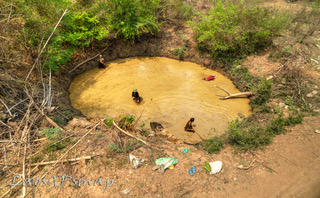
Thos tiny blips in this waterhole are people swimming. The waterhole is one single bomb crater on the Ho Chi Minh Trail in eastern Laos
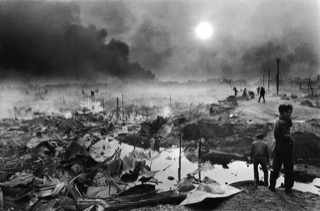
Crossing the Mekong at night would be similar to this
picture only pitch black
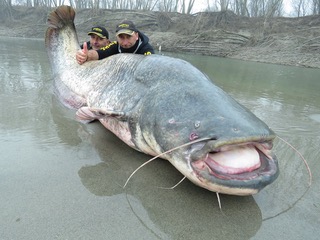
The Mekong River has catfish of huge size
